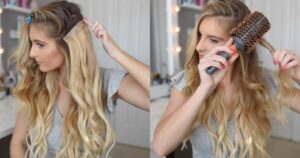If you use more hair color than a developer, you might end up with uneven and unpredictable results. Hair color needs a developer to activate and work properly, so an imbalance can lead to uneven coloring or a shade that’s too intense.
It’s essential to follow the recommended proportions in your hair coloring instructions to achieve the best and most consistent outcome. Using too much color relative to the developer can also be harsh on your hair and could potentially damage it. So, it’s best to stick to the prescribed ratios for a successful and safe coloring experience.
The Importance of Proper Ratio
The key to successful hair coloring lies in maintaining the right ratio between hair color and developer. Most hair color products come with specific instructions for mixing these two components. Deviating from these recommendations can result in various issues:
Inadequate Color Development
When you use more hair color than a developer, the excess color may not properly penetrate the hair shaft. This can result in inadequate color development, leaving you with a patchy and uneven hair color. In essence, your hair may look splotchy and far from the uniform shade you intended to achieve.
Furthermore, without the proper amount of developer, the chemical reaction between the color and your hair’s natural pigments may not proceed as it should. The developer’s primary role is to lift the hair cuticle and allow the color to enter the cortex, where it can alter the hair’s natural color. Without enough development, the color molecules may struggle to penetrate, leading to a less vibrant and shorter-lasting result.
Overly Intense Color
Conversely, using excessive hair color can lead to a color that is overly intense or too dark. When you use more color than the developer can effectively manage, the result can be a shade that is much deeper and more saturated than you had in mind. This can be particularly problematic if you were aiming for a subtle change, and instead, you find yourself with a dramatic, almost theatrical look.
Moreover, overly intense colors can be challenging to maintain. They tend to fade unevenly, leaving you with a discolored, patchy mess. This can lead to more frequent touch-ups and additional stress on your hair.
Increased Risk of Damage
The developer in hair color also plays a crucial role in protecting your hair during the coloring process. It helps to control the speed of the color reaction and ensures that your hair doesn’t suffer excessive damage. Using more hair color than a developer can increase the risk of damage to your hair in several ways:

Weakened Structure
Excessive hair color can contain higher levels of ammonia or other harsh chemicals, which can weaken the structure of your hair. This is particularly problematic if you have fine or fragile hair. Weakened hair is more prone to breakage and split ends, leaving your locks looking less than healthy. To avoid such issues, it’s crucial to measure hair color and developer accurately to ensure a balanced and safe formula for your specific hair type.
Irritation and Allergic Reactions
Using too much hair color can lead to an increased concentration of potentially irritating ingredients. This may result in scalp irritation, itching, or even allergic reactions in some individuals. It’s essential to follow the manufacturer’s instructions regarding the mixing ratio to minimize the risk of adverse reactions.
Difficulty in Correction
If you end up with hair that’s the wrong color due to an imbalanced ratio of hair color to the developer, correcting it can be a complex and costly process. Professional colorists may need to strip the color from your hair or use color correction techniques to get it back to your desired shade. These processes can be harsh on your hair and may require multiple sessions to achieve the desired result.
Possible Effects of Using More Hair Color Than Developer
| Effect | Description |
| Uneven Color | Excess hair color may result in a patchy, uneven look. |
| Overly Intense Color | The color may be much darker and more vibrant than intended. |
| Hair Damage | Excessive chemicals can weaken the hair structure. |
| Scalp Irritation | An imbalanced ratio may lead to scalp irritation. |
| Difficulty in Correction | Fixing the issue can be a complex and costly process. |
This table gives a brief overview of some of the potential consequences of using more hair color than the developer. Keep in mind that the specific outcomes can vary depending on factors such as the individual’s hair type, the product used, and the extent of the deviation from recommended ratios.
How to Avoid Using More Hair Color Than Developer
To ensure your hair coloring experience is a success, it’s crucial to follow the manufacturer’s instructions for mixing hair color and developer. Here are some additional tips to avoid using more hair color than the developer:
Measure Accurately
Invest in a good quality, accurate measuring cup or scale to ensure you are following the recommended ratio precisely. This step might seem minor, but it’s essential for achieving the desired results.
Follow Instructions
Read and follow the instructions provided with the hair color product carefully. Each brand and product may have specific guidelines for mixing ratios and application techniques.
Consult a Professional
If you’re uncertain about the process or are looking for a complex color change, it’s best to consult a professional hair colorist. They have the knowledge and experience to ensure your hair color turns out just as you envisioned.
Frequently Asked Question
What happens if I use more hair color than the developer?
If you use more hair color than a developer, you may end up with uneven and unpredictable results. The hair color needs a developer to work correctly, and an imbalance can lead to uneven coloring or a shade that’s too intense.
Why is the proper ratio between hair color and developer important?
Maintaining the right ratio is crucial because it ensures adequate color development, prevents overly intense colors, and reduces the risk of hair damage during the coloring process.
What are the consequences of using more hair color than the developer?
Using excessive hair color can result in uneven color, overly intense shades, hair damage, scalp irritation, and difficulty in correction.
How can I avoid using more hair color than the developer?
To avoid this issue, you should measure accurately, follow product instructions, and consider consulting a professional hair colorist if you’re unsure about the process.
What are the potential risks of not following the recommended ratios when coloring hair?
Not following the recommended ratios can result in poor color development, intense colors, hair damage, scalp irritation, and the need for complex and costly correction.
Conclusion:
In conclusion, the proper balance between hair color and the developer is essential for achieving the best and most consistent results when coloring your hair. Using more hair color than a developer can lead to uneven, intense, and potentially damaging outcomes. It’s crucial to adhere to the recommended proportions outlined in your hair coloring instructions, as this maintains the integrity of the coloring process and ensures your hair remains healthy and vibrant.
Furthermore, following these guidelines helps to minimize the risk of scalp irritation and allergic reactions, making your hair coloring experience not only beautiful but also safe. If in doubt, seeking the expertise of a professional hair colorist is a wise choice, as they can help you achieve your desired look without the pitfalls of imbalanced ratios.











